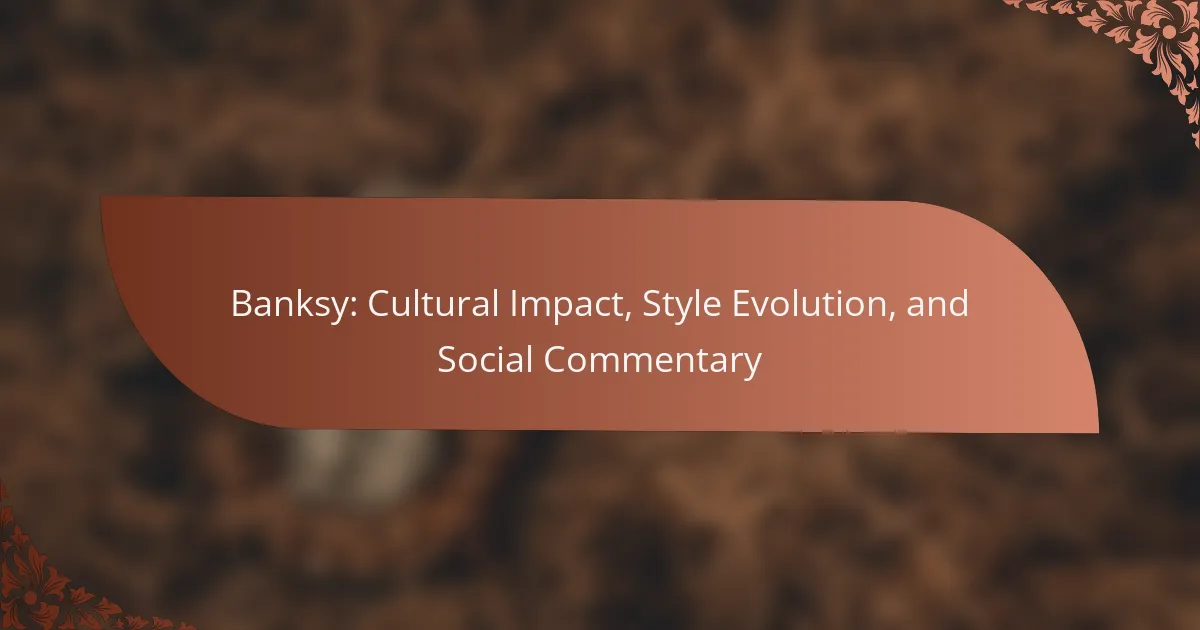Banksy has reshaped contemporary art and culture through his impactful street art, which combines social commentary and political activism. This article explores his style evolution, the significance of his anonymity, regional perceptions of his work, and the role of social media in amplifying his messages. Additionally, it addresses the controversies surrounding his art and the lessons learned from his unique approach to social critique.
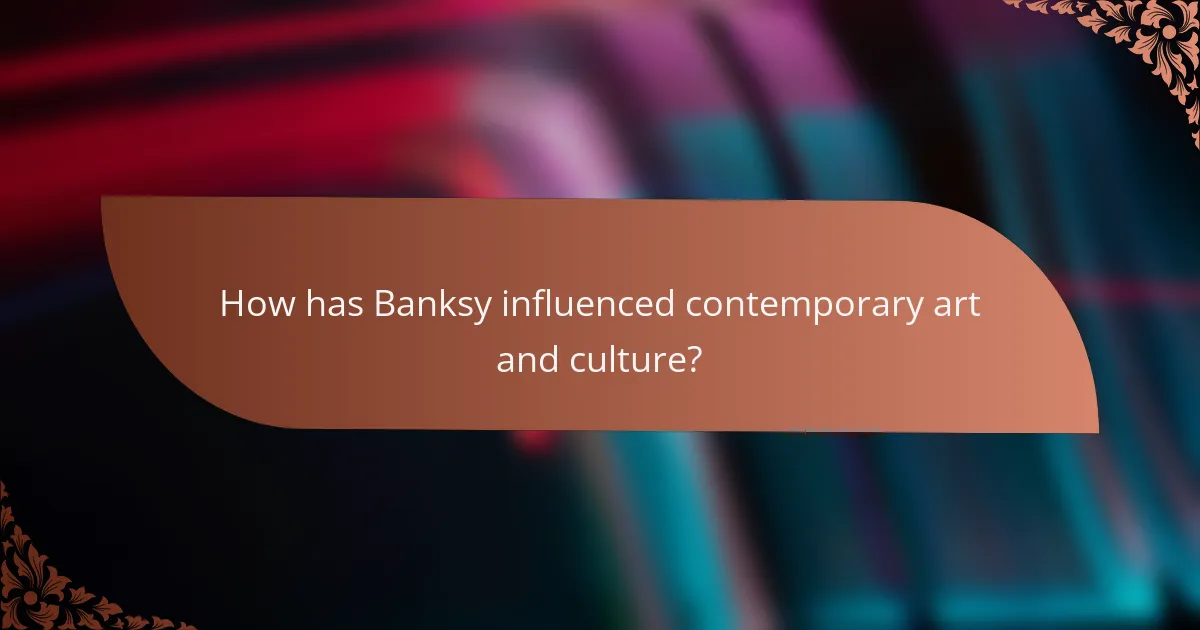
How has Banksy influenced contemporary art and culture?
Banksy has profoundly influenced contemporary art and culture through his unique style, social commentary, and political activism. His street art challenges societal norms and provokes thought on various issues, such as consumerism and war. Banksy’s anonymity adds an intriguing layer, making his work more impactful and relatable. He has inspired a generation of artists to use public spaces for expression, blending art with activism. Additionally, his pieces often spark conversations about the value of art, ownership, and the role of the artist in society.
What are the key themes in Banksy’s work?
Banksy’s work is characterized by themes of social justice, anti-establishment sentiment, and the critique of consumerism. His art often addresses political issues, environmental concerns, and the human condition. Unique attributes include his anonymity and use of public spaces for art. Rarely, his pieces incorporate interactive elements that engage viewers directly. Overall, Banksy’s style evolves from graffiti roots to contemporary art, reflecting cultural shifts and societal challenges.
How do Banksy’s works reflect societal issues?
Banksy’s works reflect societal issues by using provocative imagery and satire to challenge norms. His art addresses topics like consumerism, war, and inequality, prompting public discourse. For example, pieces like “Girl with a Balloon” symbolize lost innocence, while “The Flower Thrower” advocates for peace. These works resonate emotionally, making complex social issues accessible. Banksy’s unique approach combines street art with political commentary, ensuring his messages remain relevant and impactful.
In what ways has Banksy reshaped public perceptions of street art?
Banksy has significantly transformed public perceptions of street art by blending social commentary with accessible visuals. His work challenges societal norms and provokes thought, making street art a legitimate form of artistic expression. Banksy’s unique style combines satire and political messages, which resonate globally. This has elevated street art from vandalism to a respected cultural phenomenon, often featured in galleries and exhibitions. As a result, public acceptance of street art has grown, encouraging new artists to explore similar themes.
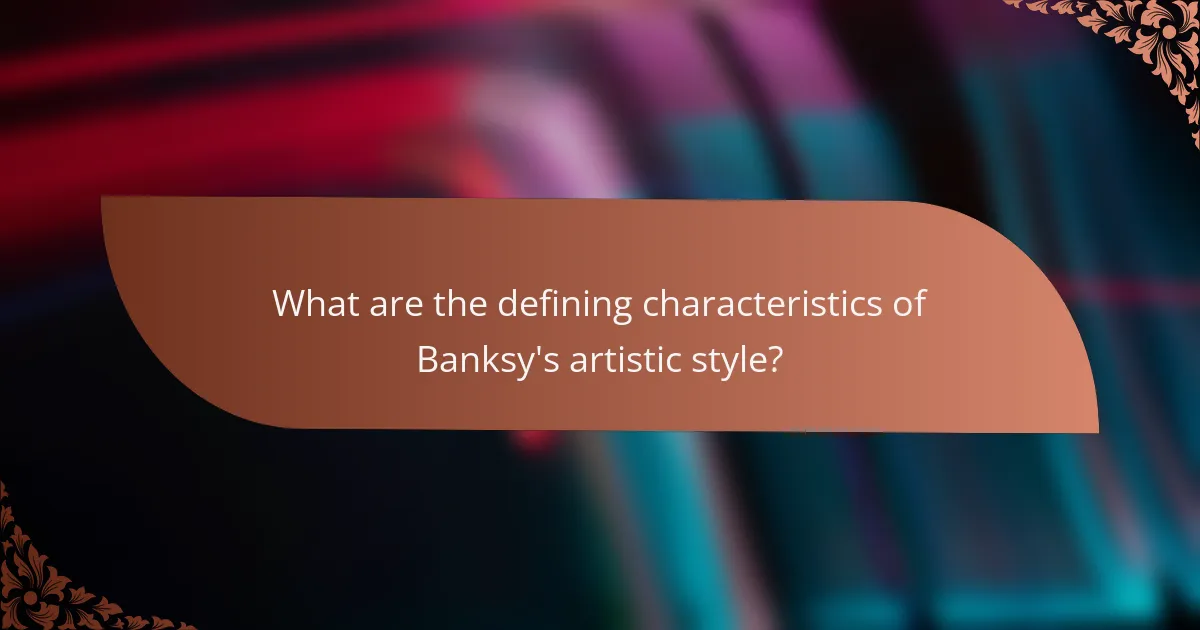
What are the defining characteristics of Banksy’s artistic style?
Banksy’s artistic style is defined by its satirical and provocative nature. His work often features social and political commentary, employing stenciling techniques for quick execution. The use of dark humor and irony is prevalent, making complex issues accessible. Unique attributes include a focus on anti-establishment themes and guerrilla art practices, which challenge conventional art spaces. Rarely, Banksy incorporates interactive elements, inviting viewer participation and reflection.
How does Banksy’s use of satire convey his messages?
Banksy’s use of satire effectively critiques societal norms and political issues. His art employs humor and irony to provoke thought and inspire change. By blending visual elements with sharp commentary, he engages viewers emotionally and intellectually. This unique approach allows him to address complex topics, making them accessible and relatable. For example, his work often highlights consumerism, war, and social injustice, prompting audiences to reflect on their values and beliefs.
What techniques does Banksy employ in his graffiti?
Banksy employs techniques such as stenciling, social satire, and visual irony in his graffiti. Stenciling allows for quick execution and reproducibility, enhancing his street art’s accessibility. Social satire critiques political and social issues, while visual irony creates striking contrasts that provoke thought. His use of public spaces amplifies the impact of his messages, engaging a broad audience. Additionally, Banksy’s anonymity adds a layer of intrigue, making his work more compelling.
Which visual elements are commonly found in Banksy’s art?
Banksy’s art commonly features stenciled images, social and political themes, and satirical humor. His work often includes iconic symbols like rats, balloons, and children, which convey deeper messages about society. The use of urban settings enhances the impact of his commentary, making it accessible to a wide audience. Additionally, Banksy employs contrasting colors and styles that draw attention and provoke thought.
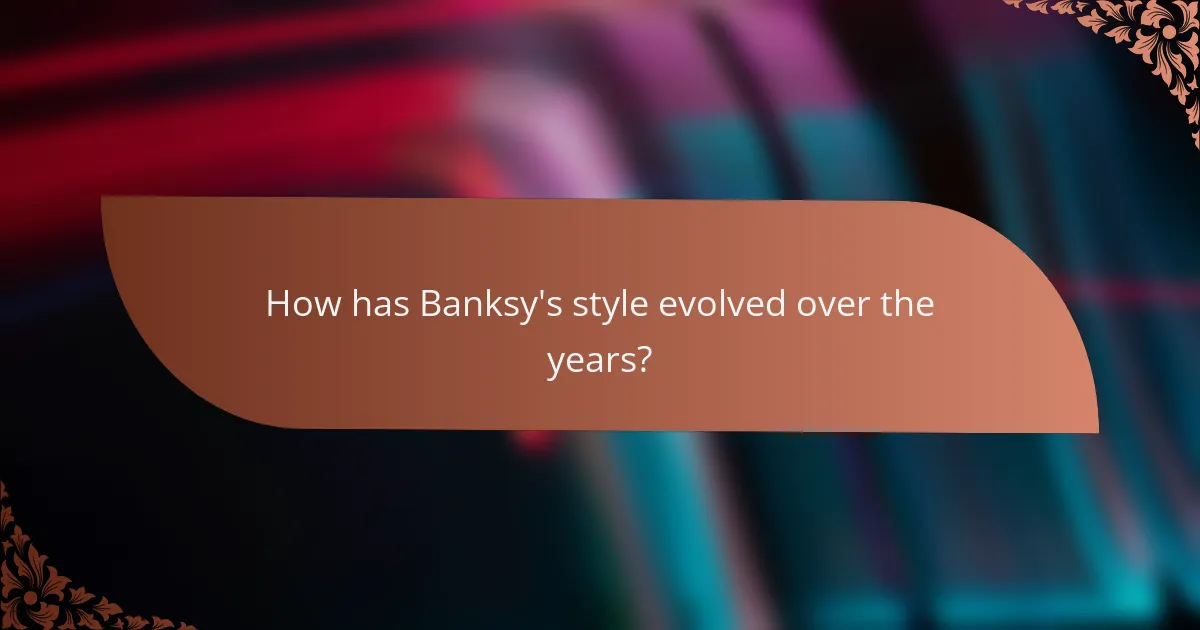
How has Banksy’s style evolved over the years?
Banksy’s style has evolved from simple graffiti to complex social commentary. Initially, his work featured stenciled images with bold political messages. Over time, he incorporated diverse techniques, including installations and multimedia art. This evolution reflects his response to changing social issues and the art world’s dynamics. Notably, his unique attribute is the ability to blend humor with critique, making his art accessible yet thought-provoking. In recent years, he has embraced technology, utilizing social media to amplify his messages, demonstrating a rare adaptability in contemporary art.
What are the major phases in Banksy’s artistic development?
Banksy’s artistic development includes several major phases: early street art, political activism, mainstream recognition, and contemporary commentary.
In the early phase, Banksy focused on stenciling techniques, often conveying anti-establishment messages. His work gained attention for its sharp social critique. As he transitioned to political activism, pieces like “Girl with a Balloon” highlighted issues such as war and poverty.
Mainstream recognition followed, with exhibitions and collaborations elevating his status. His unique blend of humor and poignancy resonated widely. In the contemporary phase, Banksy continues to address pressing social issues, utilizing public spaces for impactful commentary. Each phase reflects his evolving style and commitment to social discourse.
How do early works compare to recent pieces?
Early works by Banksy often emphasize direct social and political commentary, while recent pieces showcase a more refined artistic style and complex themes. The evolution reflects a shift from straightforward messages to layered narratives. For instance, early graffiti focused on anti-establishment sentiments, whereas recent installations incorporate humor and irony. This progression highlights Banksy’s unique ability to adapt to cultural contexts while maintaining his core message.
What influences have shaped Banksy’s artistic journey?
Banksy’s artistic journey has been shaped by social, political, and cultural influences. His work often reflects societal issues, drawing inspiration from urban environments and contemporary events. The rise of street art as a legitimate form of expression has also impacted his style evolution. Additionally, the anonymity surrounding his identity adds a unique layer to his commentary on consumerism and capitalism. Influences from punk culture and early graffiti movements further define his artistic narrative.
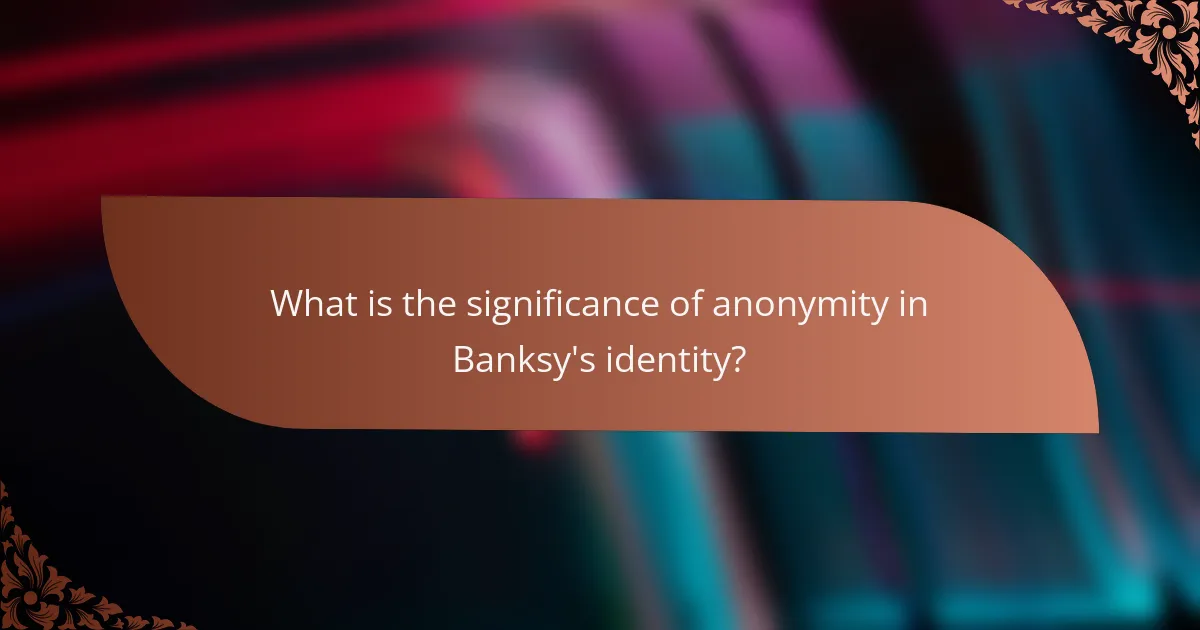
What is the significance of anonymity in Banksy’s identity?
Anonymity is crucial to Banksy’s identity as it enhances the impact of his social commentary. By remaining unknown, he challenges societal norms and provokes thought without the influence of his personal identity. This unique attribute allows his art to speak universally, focusing on the message rather than the artist. Anonymity cultivates intrigue, drawing attention to the themes of consumerism and political issues in his work. As a result, it amplifies his cultural significance, making his pieces iconic and thought-provoking.
How does anonymity enhance the impact of his art?
Anonymity enhances Banksy’s art by creating intrigue and allowing viewers to focus on the message rather than the artist’s identity. This lack of personal branding fosters a universal connection to his social commentary. The mystery surrounding his persona amplifies the impact of his work, inviting diverse interpretations and discussions. As a result, his art resonates more deeply with audiences, elevating its cultural significance.
What theories exist regarding Banksy’s true identity?
Several theories suggest Banksy’s true identity, with the most prominent candidates being street artist Robin Gunningham and graffiti artist Thierry Guetta. Gunningham’s connections to various locations and art scenes support his candidacy, while Guetta, known as “Mr. Brainwash,” gained fame through his documentary about street art. Other theories propose that Banksy is a collective of artists or even a well-known figure like Damien Hirst. Each theory highlights the mystery surrounding Banksy’s identity, enhancing his cultural impact.
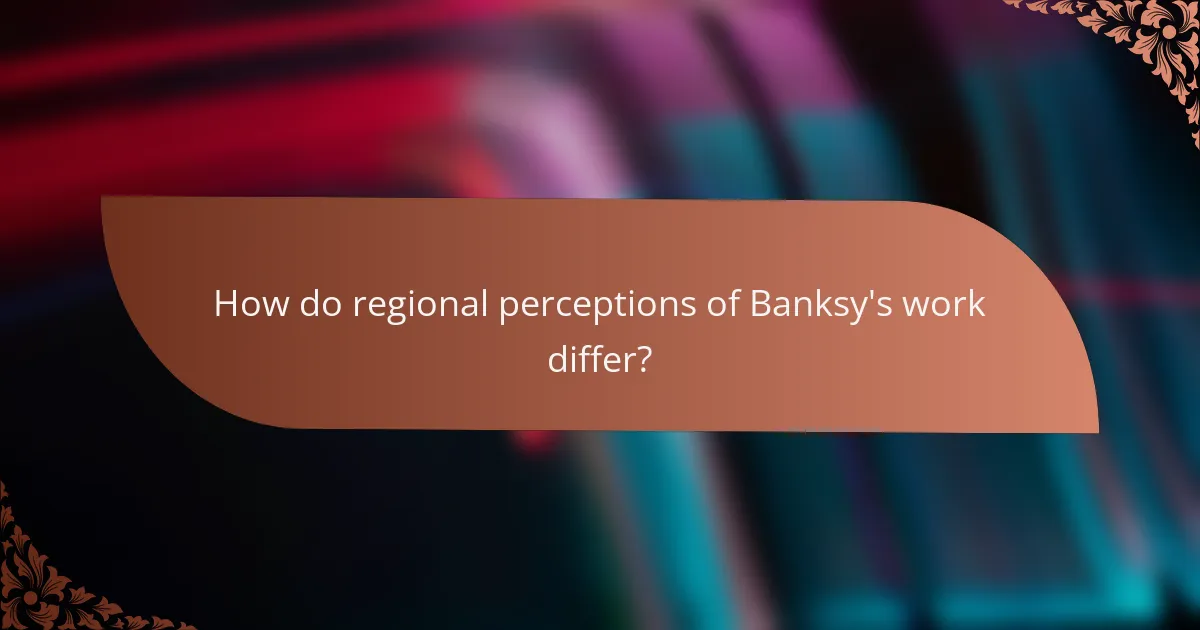
How do regional perceptions of Banksy’s work differ?
Regional perceptions of Banksy’s work vary significantly based on cultural context and social issues. In the UK, his art often reflects local political sentiments, while in the US, it tends to resonate with broader themes of consumerism and identity. For example, in Palestine, his pieces comment on the Israeli-Palestinian conflict, emphasizing resistance and hope. In contrast, in urban centers like New York, his work is viewed through the lens of street art, often celebrated for its aesthetic value. These differing perspectives shape the interpretation and appreciation of his art across regions, highlighting the unique attributes of each cultural landscape.
What cultural contexts influence the reception of Banksy’s art?
Banksy’s art is influenced by cultural contexts such as socio-political climates, urban environments, and public sentiment. His work often reflects societal issues, challenging authority and provoking thought. The reception varies globally, shaped by local cultural narratives and historical events. For example, in regions with political unrest, his art may be seen as a form of resistance, while in more affluent areas, it might be interpreted as a critique of consumerism. The unique attribute of Banksy’s anonymity adds to the intrigue and cultural discourse surrounding his pieces.
How do local events shape the interpretation of Banksy’s messages?
Local events significantly influence how audiences perceive Banksy’s messages. These events provide context, allowing viewers to connect with the art on a personal and cultural level. For instance, a mural created during a political protest may resonate differently than one displayed at a local festival. This situational backdrop often amplifies the social commentary embedded in Banksy’s work, making it more relevant and impactful. Community engagement enhances the interpretation, as local narratives shape the understanding of the themes Banksy explores.
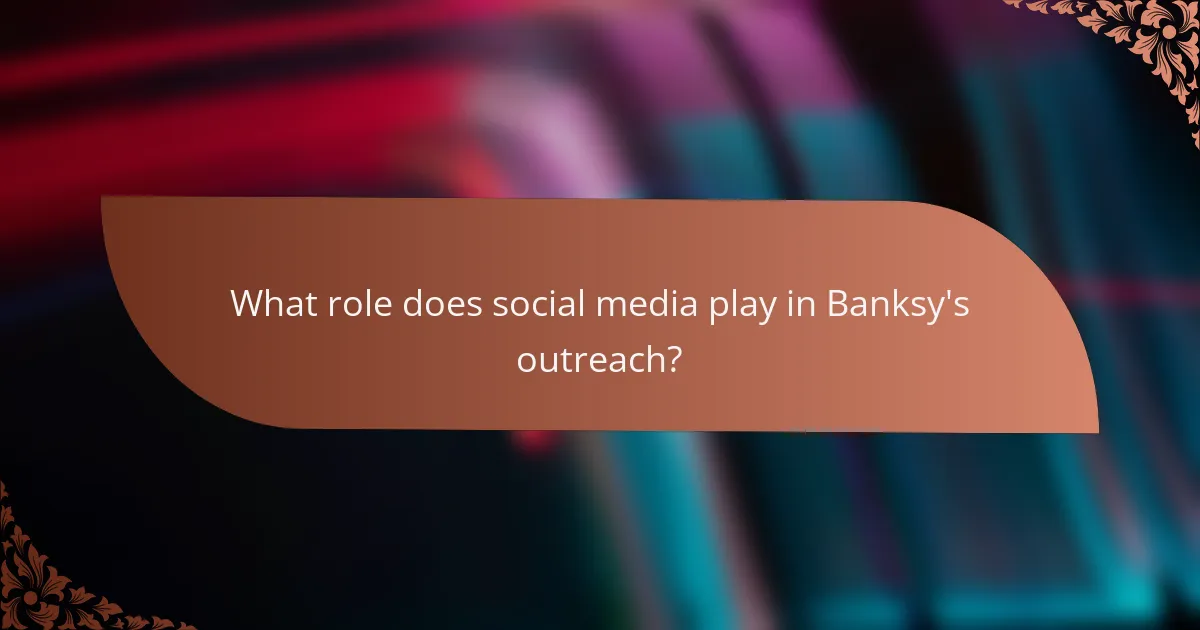
What role does social media play in Banksy’s outreach?
Social media amplifies Banksy’s outreach by enabling rapid dissemination of his art and messages. Platforms like Instagram and Twitter allow him to connect with a global audience instantly. His works often provoke discussions on social issues, leveraging virality to enhance cultural impact. The anonymity of his identity adds intrigue, encouraging shares and engagement, further broadening his influence.
How has social media changed the way Banksy’s art is disseminated?
Social media has significantly transformed how Banksy’s art reaches audiences. It enables instant sharing, broadening exposure and engagement. Platforms like Instagram and Twitter allow real-time dissemination, amplifying the impact of his work. This shift enhances Banksy’s ability to comment on social issues, as his art can quickly resonate with global audiences. Additionally, social media allows fans to interact, fostering a community that further promotes his messages and artistic evolution.
What impact does online engagement have on Banksy’s brand?
Online engagement significantly enhances Banksy’s brand visibility and cultural relevance. It fosters a global dialogue, allowing diverse audiences to interpret his art and social commentary. Social media platforms amplify his impact, creating a community that shares and discusses his work. This interaction reinforces his unique attribute of anonymity while expanding his reach, making Banksy a pivotal figure in contemporary art.
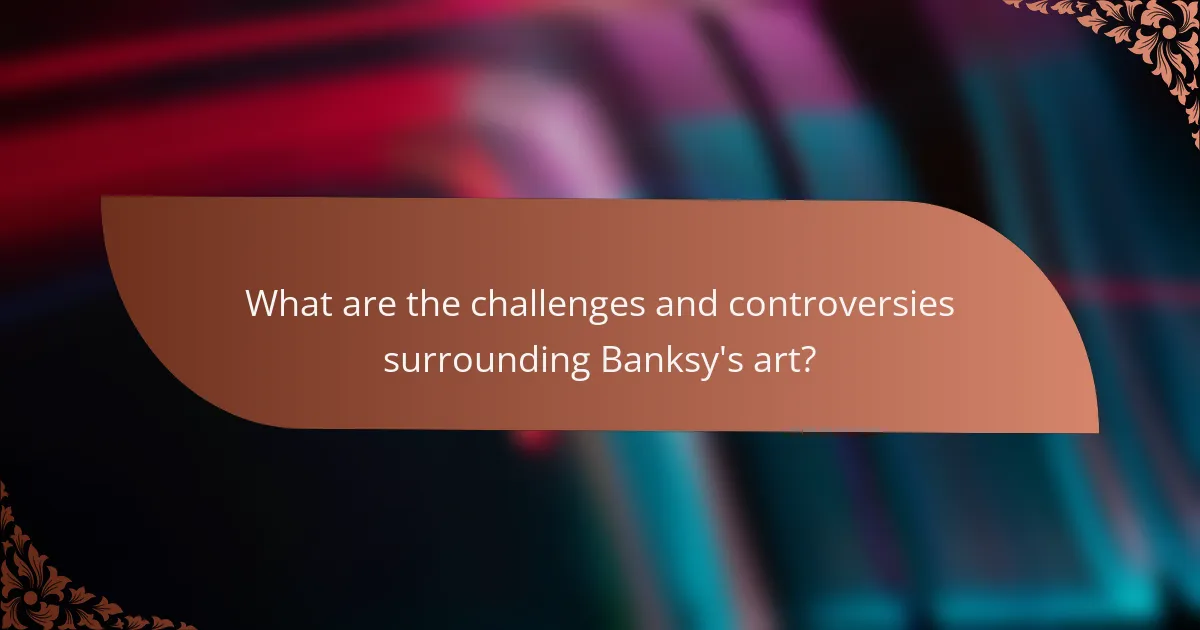
What are the challenges and controversies surrounding Banksy’s art?
Banksy’s art faces challenges and controversies due to its provocative nature and the anonymity of its creator. Critics argue that his work often blurs the lines between art and vandalism, raising ethical questions about public space usage. Additionally, the commercialization of his art contradicts his anti-establishment messages, leading to debates on authenticity and intent. The unique attribute of Banksy’s anonymity adds intrigue but complicates discussions on authorship and ownership. As a result, his pieces frequently spark public discourse on social issues, highlighting the tension between art and activism.
How do legal issues affect street art and Banksy’s works?
Legal issues significantly impact street art and Banksy’s works by influencing their visibility and preservation. Legal frameworks often determine whether street art is considered vandalism or protected expression. For instance, Banksy’s works frequently face removal or destruction due to property laws. Additionally, copyright disputes arise over unauthorized reproductions of his art, complicating the commercialization of his pieces. The legal landscape shapes public perception and the cultural significance of Banksy’s contributions, highlighting the tension between artistic freedom and legal constraints.
What criticisms has Banksy faced in the art community?
Banksy has faced criticism for commercializing street art and lacking artistic originality. Critics argue his work sometimes oversimplifies complex issues. Some artists feel his fame overshadows emerging talents. Others question the authenticity of his social commentary. Additionally, the commercialization of his pieces raises concerns about the integrity of street art.
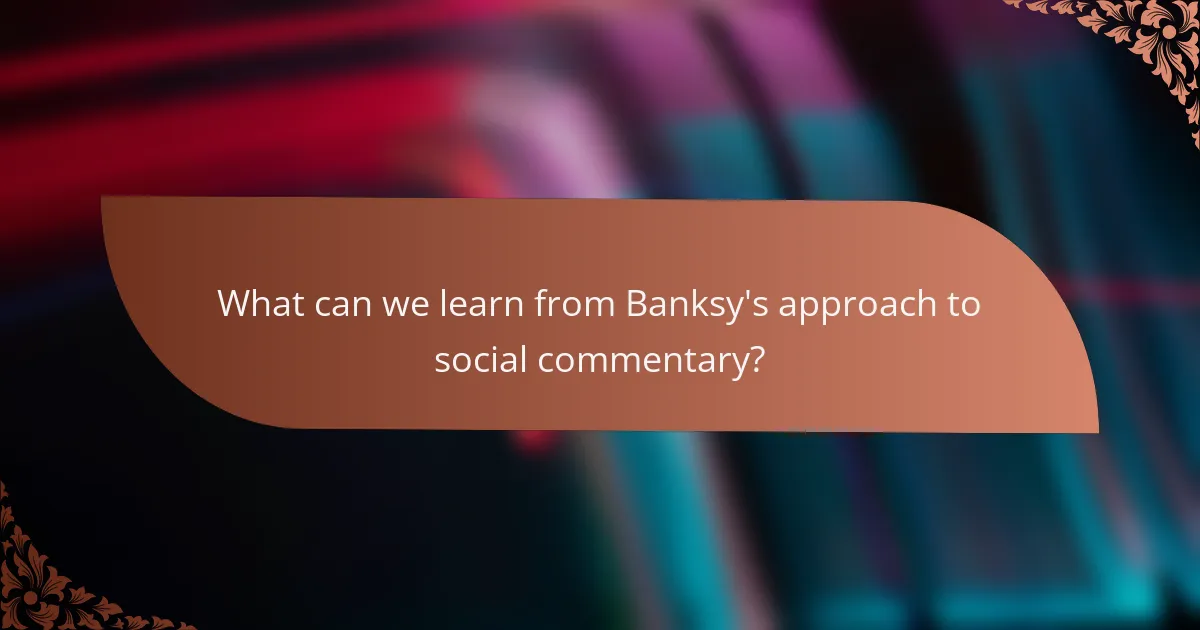
What can we learn from Banksy’s approach to social commentary?
Banksy’s approach to social commentary teaches us the power of anonymity and subversion. His art challenges societal norms and provokes thought through striking visuals and clever messaging. By employing urban spaces, he creates accessible art that engages a broad audience. His unique blend of humor and critique highlights social injustices, making complex issues relatable. This method encourages public discourse and inspires activism, demonstrating art’s potential to effect change.
How can artists utilize satire to address social issues?
Artists can utilize satire to address social issues by highlighting injustices and provoking thought. Banksy exemplifies this method through his provocative street art, which critiques consumerism and government policies. His unique style evolves by incorporating humor and irony, making complex themes accessible. By using visual metaphors, Banksy engages audiences and fosters dialogue about critical societal problems.
What best practices can be derived from Banksy’s methods?
Banksy’s methods emphasize anonymity, social engagement, and provocative imagery. These best practices can enhance artistic impact and audience connection.
1. Embrace anonymity to create intrigue and focus on the message.
2. Use public spaces for art to engage wider audiences.
3. Incorporate social commentary to provoke thought and discussion.
4. Adapt style and technique to reflect current events and cultural shifts.
5. Foster community involvement to build a shared narrative around the artwork.
